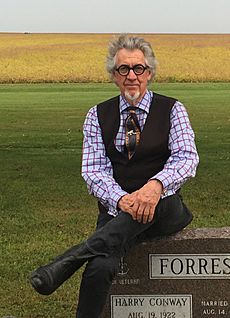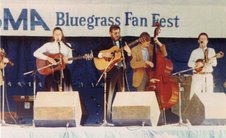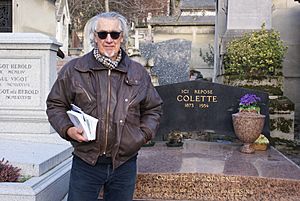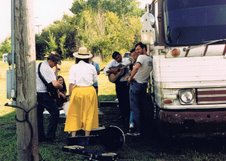Gary Jeshel Forrester facts for kids
Quick facts for kids
Gary (Jeshel) Forrester
|
|
|---|---|

Forrester in Morrisonville, Illinois in 2016.
|
|
| Born | 3 July 1946 Decatur, Illinois, U.S. |
| Occupation |
|
| Genre | Novels, poetry, short stories, memoirs, bluegrass |
| Literary movement | Metamodernism |
| Children | Sam Harding Forrester, Joseph Harding Forrester, Lucy Jeshel McCallum, Georgette Brown (step-daughter), Charlotte Rose Forrester, Haz Forrester |
Gary (Jeshel) Forrester (born July 3, 1946) is an American musician, writer, and lawyer who has lived in Rotorua, New Zealand for many years. He is known for having many different talents. A New Zealand magazine once called him a "modern Renaissance man" because he is skilled in so many areas.
Forrester has worked as a university teacher, a lawyer for indigenous rights, a bluegrass musician, and a writer of novels and poems. He has taught at universities in the United States, Australia, and New Zealand. In 2024, at the age of 78, he joined the Peace Corps for a second time to teach in the country of Georgia. This made him one of the oldest people to ever serve in the Peace Corps.
He is also known for his work helping Native American tribes. In the 1980s, he helped tribes get their rights recognized by the United States Congress. He also wrote a book and many articles about the rights of native peoples around the world.
Contents
Music Career
Forrester is a talented songwriter and musician, especially in bluegrass, folk, and Americana styles. He recorded music under the name Eddie Rambeaux with his band, the Rank Strangers.
The Rank Strangers
The Rank Strangers became very popular in Australia in the late 1980s. Their music was praised for its high-quality songwriting and classic bluegrass sound. Critics compared them to famous musicians like The Stanley Brothers and Bill Monroe.
Their albums, Dust on the Bible and Uluru, won many awards. In 1988, the band won Best Group, Best Male Vocalist, and Best Composition at the Australian Gospel Music Awards. They were also finalists in the main Australian Country Music Awards.
The band toured Australia and the United States, playing with famous artists like Bill Monroe, Alison Krauss, and Emmylou Harris. The American magazine Bluegrass Unlimited praised their unique style and said their music was "one of the most intellectually stimulating bluegrass works of recent years."
Solo Music
After the Rank Strangers, Forrester began releasing solo albums. Between 2015 and 2018, he released three albums: Alma Rose, Jeshel, and The Old Churchyard. These albums featured his simple, honest style with just his voice, guitar, and harmonica.
Music critics gave his solo work high praise. They compared his storytelling to great artists like Johnny Cash, Bob Dylan, and Kris Kristofferson. One critic for the New Zealand Listener described his album Jeshel as a "stunning double album of country folk" with powerful stories. Another review said his music was "simple and down-to-earth, just straightforward honesty."
Writing Career
After his time with the Rank Strangers, Forrester focused more on writing novels, poetry, and memoirs. His writing often explores themes of family, music, and travel.
Novels and Poetry
- Houseboating in the Ozarks (2006): This novel tells the story of a family's journey through the American Midwest. It explores different spiritual traditions, including those of Native American and Australian Aboriginal peoples.
- The Connoisseur of Love (2012): Set in Wellington, New Zealand, this novel is about a man who feels like an outsider in his own city. A local magazine called it a "love song" to Wellington.
- Begotten, Not Made: This novel is about a musician and his deaf friend on a walking journey from New York to San Francisco in the 1920s. It is written in a unique style called free verse.
- More Deaths than One (2014): This book follows a journey from New Zealand to America. The main character explores the life of the late author David Foster Wallace and the meaning of life.
- The Beautiful Daughters of Men (2009): This is a book of poems about two people who move to New Zealand, one from Chechnya and one who is a dying man.
Memoirs and Biographies
Forrester has also written about his own life and the lives of others. His 2011 memoir, Blaw, Hunter, Blaw Thy Horn, is about his parents and their life in Illinois. It tells the important story of his father, a basketball coach who helped break down racial barriers in the 1950s by having a team with five Black players.
In 2023, his biography of the writer Philip F. Deaver was published. He also wrote a fun history of a famous bookstore in Rotorua, New Zealand.
Working for Native American Rights
Forrester is a descendant of Cherokee and Melungeon people on his mother's side. In the 1980s, he lived on the Cheyenne River Indian Reservation in South Dakota and worked as a lawyer for Native American rights. He learned to play bluegrass music from members of the Lakota tribe.
He helped several tribes, including the Confederated Tribes of the Grand Ronde Community of Oregon and the Klamath Tribes, to get their treaty rights restored by the U.S. government. This was a huge victory after many years of struggle for these tribes.
Forrester also argued important cases in court. In one case, he successfully argued that police had violated a prisoner's rights by not keeping him safe. His work helped protect the rights of many people.
For his work, he was given the honorary Lakota name "Jeshel," which means "meadowlark" or "messenger." He received the name after a meadowlark landed on his shoulder during a sacred sundance ceremony.
Personal Life
Forrester was born in Decatur, Illinois. He grew up in several towns in Illinois before spending much of his adult life living in other countries.
His father, Harry Forrester, was a famous basketball coach who is remembered for his courage in fighting racism in sports during the 1950s. His mother, Alma Rose Grundy, came from a musical family. One of her relatives was Otto Funk, a fiddler who once walked from New York to San Francisco while playing his violin the entire way.
During the Vietnam War, Forrester was a conscientious objector, meaning he was against the war for moral reasons. Instead of fighting, he served in the Peace Corps in Guyana, South America.
After living and working in Australia, he and his family moved to Wellington, New Zealand, in 2006. He has six children and has also been an organic farmer and a vegetarian.
Images for kids
Selected Discography
Here are some of Forrester's most well-known albums.
With the Rank Strangers
- Dust on the Bible (1988)
- Uluru (1989)
- Kamara (1990)
Solo Albums
- Alma Rose (2015)
- Jeshel (2016)
- The Old Churchyard (2018)
- The Covid Phone Album (2020)







